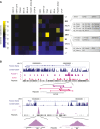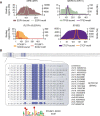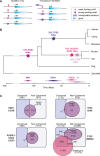Evolution of the mammalian transcription factor binding repertoire via transposable elements
- PMID: 18682548
- PMCID: PMC2577865
- DOI: 10.1101/gr.080663.108
Evolution of the mammalian transcription factor binding repertoire via transposable elements
Abstract
Identification of lineage-specific innovations in genomic control elements is critical for understanding transcriptional regulatory networks and phenotypic heterogeneity. We analyzed, from an evolutionary perspective, the binding regions of seven mammalian transcription factors (ESR1, TP53, MYC, RELA, POU5F1, SOX2, and CTCF) identified on a genome-wide scale by different chromatin immunoprecipitation approaches and found that only a minority of sites appear to be conserved at the sequence level. Instead, we uncovered a pervasive association with genomic repeats by showing that a large fraction of the bona fide binding sites for five of the seven transcription factors (ESR1, TP53, POU5F1, SOX2, and CTCF) are embedded in distinctive families of transposable elements. Using the age of the repeats, we established that these repeat-associated binding sites (RABS) have been associated with significant regulatory expansions throughout the mammalian phylogeny. We validated the functional significance of these RABS by showing that they are over-represented in proximity of regulated genes and that the binding motifs within these repeats have undergone evolutionary selection. Our results demonstrate that transcriptional regulatory networks are highly dynamic in eukaryotic genomes and that transposable elements play an important role in expanding the repertoire of binding sites.
Figures





References
-
- Barski A., Cuddapah S., Cui K., Roh T.Y., Schones D.E., Wang Z., Wei G., Chepelev I., Zhao K. High-resolution profiling of histone methylations in the human genome. Cell. 2007;129:823–837. - PubMed
-
- Bejerano G., Lowe C.B., Ahituv N., King B., Siepel A., Salama S.R., Rubin E.M., Kent W.J., Haussler D. A distal enhancer and an ultraconserved exon are derived from a novel retroposon. Nature. 2006;441:87–90. - PubMed
-
- Bell A.C., West A.G., Felsenfeld G. The protein CTCF is required for the enhancer blocking activity of vertebrate insulators. Cell. 1999;98:387–396. - PubMed
-
- Boffelli D., Nobrega M.A., Rubin E.M. Comparative genomics at the vertebrate extremes. Nat. Rev. Genet. 2004;5:456–465. - PubMed
Publication types
MeSH terms
Substances
LinkOut - more resources
Full Text Sources
Other Literature Sources
Research Materials
Miscellaneous
